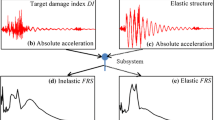Abstract
In order to propose a seismic design spectrum that includes the effect of rupture directivity in the near-fault region, this study investigates the application of equivalent pulses to the parameter attenuation relationships developed for near-fault, forward-directivity motions. Near-fault ground motions are represented by equivalent pulses with different waveforms defined by a small number of parameters (peak acceleration, A, and velocity V; and pulse period, T v ). Dimensionless ratios between these parameters (e.g., AT v /V, VT v /D) and response spectral shapes and amplitudes are examined for different pulses to gain insight on their dependence on basic pulse waveforms. Ratios of AT v /V, VT v /D, and the ratio of pulse period to the period for peak spectral velocity (T v-p) are utilized to quantify the difference between rock and soil sites for near-fault forward-directivity ground motions. The AT v /V ratio of recorded near-fault motions is substantially larger for rock sites than that for soil sites, while T v-p/T v ratios are smaller at rock sites than at soil sites. Furthermore, using simple pulses and available predictive relationships for the pulse parameters, a preliminary model for the design acceleration response spectra for the near-fault region that includes the dependence on magnitude, rupture distance, and local site conditions are developed.
Similar content being viewed by others
References
Alavi B and Krawinkler H (2000), “Considerations of Near-Fault Ground Motion Effects in Seismic Design,” Proceedings of the 12th World Conference on Earthquake Engineering, New Zealand, Paper No.: 2665.
Alavi B and Krawinkler H (2004), “Behavior of Moment-resisting Frame Structures Subjected to Near-fault Ground Motions,” Earthquake Engng Struct. Dyn, 33:687–706.
Bray JD and Rodriguez-Marek A (2004), “Characterization of Forward-directivity Ground Motions in the Near-fault Region,” Soil Dynamics and Earthquake Engineering, 24: 815–828.
Cuesta I and Aschheim MA (2004), “The Use of Simple Pulses to Estimate Inelastic Response Spectra,” Earthquake Engineering, 8(6):865–893.
Dai J, Tong M, Lee GC, Qi X and Bai W (2004), “Dynamic Responses Under the Excitation of Pulse Sequences,” Earthquake Engineering and Engineering Vibration, 3(2): 157–169.
Faccioli E, Paolucci R and Rey J (2004), “Displacement Spectra for Long Periods,” Earthquake Spectra, 20(2): 347–376.
GB50011-2001 (2001), Code for Seismic Design of Buildings, China Industry Publisher, Beijing. (in Chinese)
Hall JF, Heaton TH, Halling MW and Wald DJ (1995), “Near-source Ground Motions and Its Effects on Flexible Buildings,” Earthquake Spectra, 11(4): 569–605.
Marshall L (2000), “Geotechnical Design Considerations,” The Seismic Design Handbook, 2nd Edition, CD-ROM.
Mavroeidis GP and Papageorgiou AS (2003), “A Mathematical Representation of Near-fault Ground Motions,” Bulletin of the Seismological Society of America, 93: 1099–1131.
Mavroeidis GP, Dong G and Papageorgiou AS (2004), “Near-fault Ground Motions, and the Response of Elastic and Inelastic Single-Degree-of-Freedom (SDOF) Systems,” Earthquake Engng Struct Dyn, 33: 1023–1049.
Mohraz B (1976), “A Study of Earthquake Response Spectra for Different Geological Conditions,” Bull Seism Soc Am, 66(3): 915–935.
Rodriguez-Marek A (2000), “Near Fault Seismic Site Response,” Ph.D. Thesis, Civil Engineering, University of California, Berkeley.
Sasani M and Bertero VV (2000), “Importance of Severe Pulse-type Ground Motions in Performance-based Engineering: Historical and Critical Review,” Proceedings of the 12th World Conference on Earthquake Engineering, Auckland, New Zealand, paper No.: 1302.
Somerville PG (2003), “Magnitude Scaling of the Near Fault Rupture Directivity Pulse,” Physics of the Earth and Planetary Interiors, 137:201–202.
Somerville PG, Smith NF, Graves RW and Abrahamson NA (1997), “Modification of Empirical Strong Ground Motion Attenuation Relations to Include the Amplitude and Duration Effects of Rupture Directivity,” Seis Res Let, 68(1): 199–222.
Xie L, Xu L and Rodriguez-Marek A (2005), “Representation of Near-fault Pulse-type Ground Motions,” Earthquake Engineering and Engineering Vibration, 4(2):191–199.
Author information
Authors and Affiliations
Corresponding author
Additional information
Supported by: International (Regional) Cooperative Research Program of China National Natural Science Foundation Under Grant No. 50420120133 and Heilongjiang Natural Science Foundation Under Grant No. ZGJ03-03
Rights and permissions
About this article
Cite this article
Xu, L., Rodriguez-Marek, A. & Xie, L. Design spectra including effect of rupture directivity in near-fault region. Earthq. Engin. Engin. Vib. 5, 159–170 (2006). https://doi.org/10.1007/s11803-006-0636-8
Received:
Accepted:
Issue Date:
DOI: https://doi.org/10.1007/s11803-006-0636-8




